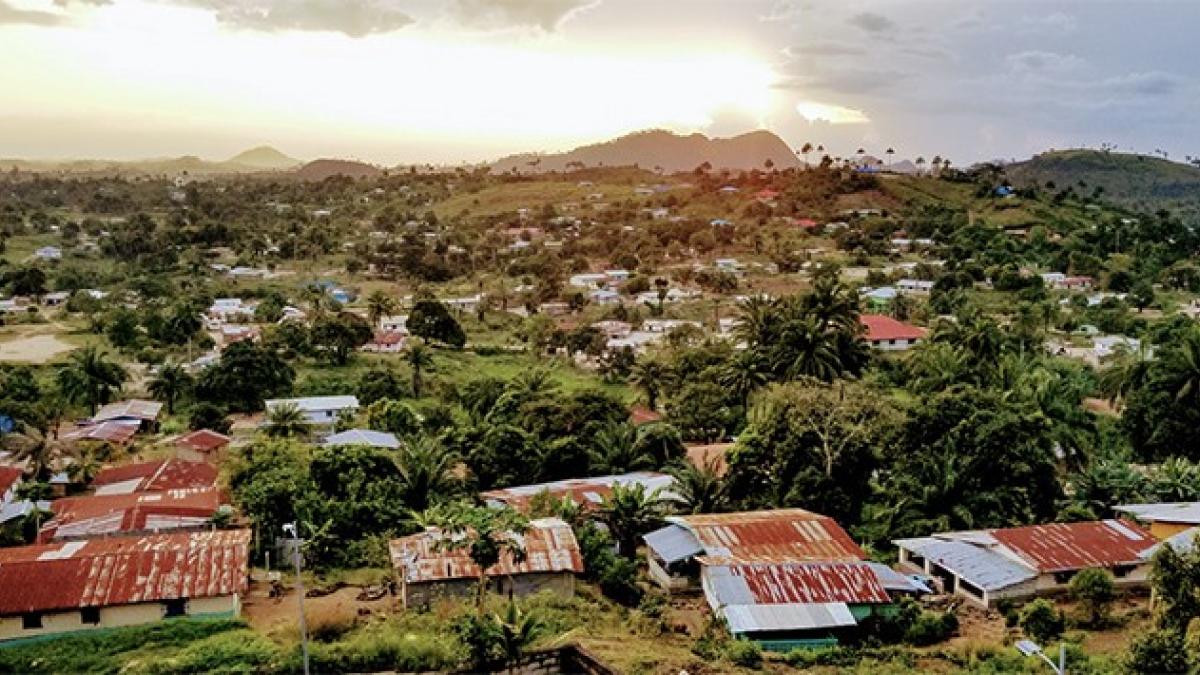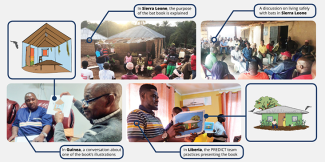
David Goodman
Ebola and Forests
In 2014, a disease began to spread quickly across West Africa, decimating the health and security of the region. The Ebola virus was first discovered in 1976, but this outbreak, from 2014–2016, was the largest and deadliest recorded in modern history. In Guinea, Liberia, and Sierra Leone, about 11,000 people died, and the resulting economic and social burden from the outbreak is estimated at more than $50 billion. Since the outbreak, researchers traced the origin back to a spillover event: a two-year-old boy in Guinea who was likely infected while playing near a tree where bats roosted.
Like SARS-CoV-2, the virus that causes COVID-19, the Ebola virus is a zoonotic pathogen that can be transmitted between animals and humans. Understanding its origins is a first step to better preventing future outbreaks and reducing transmission—including in the new 2021 Ebola cases that emerged in Guinea and the Democratic Republic of the Congo. The Center for International Forestry Research (CIFOR), as part of a long-running partnership with USAID, has been at the forefront of researching these connections, particularly identifying when, where, and under what conditions disease outbreaks may occur. In 2017, CIFOR and partners found one critical link to Ebola: deforestation. Ebola outbreaks in West Africa occurred more in areas with recent deforestation—within about two years—and forest fragmentation, in which clearing of large forests creates smaller, often disconnected areas of forest.
Building on this evidence of correlations between human and forest health, CIFOR researchers began exploring how forest fragmentation may increase human-wildlife interactions. The research looked at ranges of certain fruit bat species suspected to be reservoirs of the Ebola virus, and how these ranges overlap with the deforested areas associated with Ebola disease outbreaks in humans. Fruit bats actually prefer more open areas, and fragmented forests may be more attractive to some species. The research supported this hypothesis and found connections between human activity, deforestation, and expanded fruit bat ranges, which could influence Ebola transmission by increasing human contact with bats.
Bats and Behavior Change
This USAID-funded research consequently raises key questions for biodiversity and wildlife conservation. How can governments and conservation practitioners protect and better manage forests while reducing human health risks and ensuring healthy populations of critical species, including bats? While bats are a known host of the Ebola virus, they also play an essential ecological role. In West Africa, fruit bats pollinate hundreds of flowering plants, including mangos, guavas, and bananas, important to the region’s food security and economy. Fruit bats also disperse seeds of wild trees that maintain and restore forests, and other bat species eat insects, helping to control many crop pests. USAID recognized the need to communicate about bats thoughtfully and effectively in West African partner countries, while also educating communities about how to reduce disease transmission. The USAID PREDICT and Breakthrough Action activities worked closely with local partners to develop a communications and behavior change plan to raise awareness about reducing disease risks while emphasizing bats’ ecological roles. The resulting picture book, Living Safely With Bats, is now available in 12 languages and adapted to different regions and cultures; given its success, it has also expanded to address living safely with many different animals.
The Roots of Deforestation
Taking a comprehensive One Health approach to address the complex connections between human and the environment is a priority for USAID. In addition to behavior change and risk reduction strategies, addressing the root causes of deforestation and supporting intact forests can proactively limit disease transmission between wildlife and humans. From 2015–2021, USAID’s West Africa Biodiversity and Climate Change (WA BiCC) program focused on these issues, including addressing the drivers of deforestation, fostering forest-friendly jobs, improving forest management across borders, and increasing resilience to climate change.
As part of this work, WA BiCC supported an important agreement between Guinea and Liberia to improve sustainable management of the 257,000-hectare Ziama-Wonegizi-Wologizi (ZWW) forest—an area of global biodiversity significance and where the 2014 Ebola outbreak emerged. The forest hosts some of the largest intact parts of the Upper Guinean forest and is home to rich biodiversity, including some of the region’s last forest elephants. But it has also suffered from too-common degradation and fragmentation, and the local communities were devastated by the 2014–2016 Ebola outbreak. Deforestation—often driven by the needs of subsistence farmers to grow food—is a multifaceted threat that reduces wildlife populations, limits the natural resources available to communities, diminishes carbon storage, and increases the risk of transmission of Ebola virus and other zoonoses.

WA BiCC
With WA BiCC’s support, governments and partners in the ZWW landscape now work together to improve forest governance and promote sustainable livelihoods to reduce over-dependence on the forest’s resources. Together, these activities aim to decrease forest degradation, create wildlife corridors, and reduce human-wildlife conflicts that can contribute to zoonotic spillover events. In 2020, forest elephants marked an early success of the cross-border management when they safely travelled through their natural habitat from Guinea to Liberia, suggesting a new and more resilient wildlife corridor.
USAID also supported biomonitoring in the ZWW forest and two other transboundary forest landscapes (Gola Forest shared by Liberia and Sierra Leone, and the Tai-Grabo-Krahn-Sapo Forest Complex of Liberia and Côte d’Ivoire). This important work established baseline data and is generating additional information on the presence and movement of animals that potentially transmit zoonotic diseases—a risk that increases as animals adapt their ranges and movement in the face of climate change and habitat degradation.
WA BiCC also initiated forest restoration activities in the Gola Forest, including supporting representatives from Liberia and Sierra Leone to map restoration opportunities using the Restoration Opportunities Assessment Methodology (ROAM). This planning tool can help policymakers and conservation practitioners restore forest habitats and repair fragmentation as part of efforts to reduce zoonotic disease risk. WA BiCC’s partner countries are home to the largest remaining patches of the Upper Guinean Forest, and the growing commitment to sustainable forest management holds great potential for transformational change in the region.
Improving Lives and Conserving the Environment
Through WA BiCC and other activities, USAID has prioritized improving lives and conserving the environment, dual goals that are closely entwined across West Africa. Public education campaigns using local radio, comic books, and theater have raised community awareness about the importance of biodiversity conservation and the links between deforestation and the emergence of diseases like Ebola and COVID-19. The engagement and training of community eco-guards in the region has also provided livelihood opportunities for women and men while inspiring new advocates for biodiversity and forest conservation.
Around the world, healthy forests are a critical component of resilience. As CIFOR’s ongoing research has shown, humans need healthy environments for our own health and well-being. By investing in both research initiatives and on-the-ground conservation action, USAID is improving local development outcomes, protecting critical species, and reducing the risk of disease spillover and transmission for the benefit of all.
This story is the second in a three-part series on USAID’s investments in One Health approaches to achieve sustainable development results. Read the first installment on human health and the environment.

